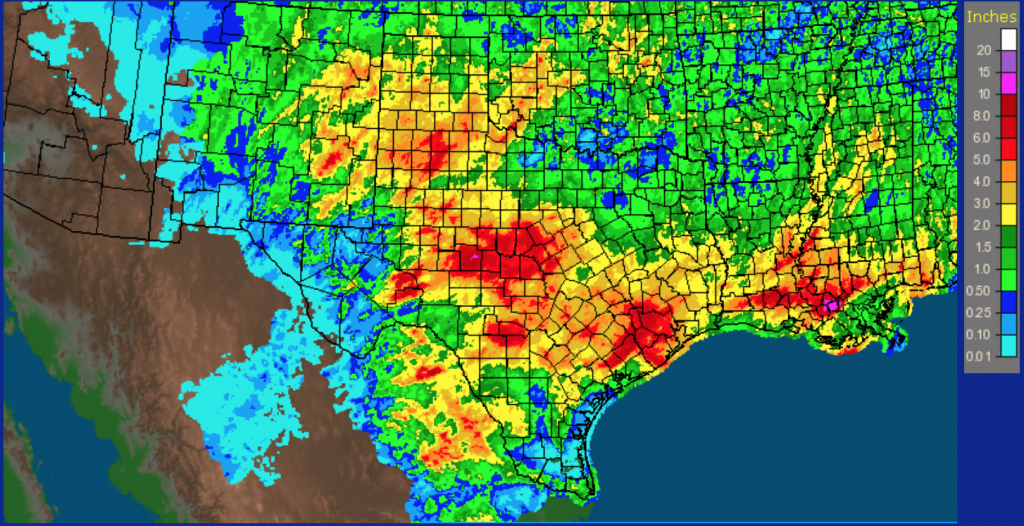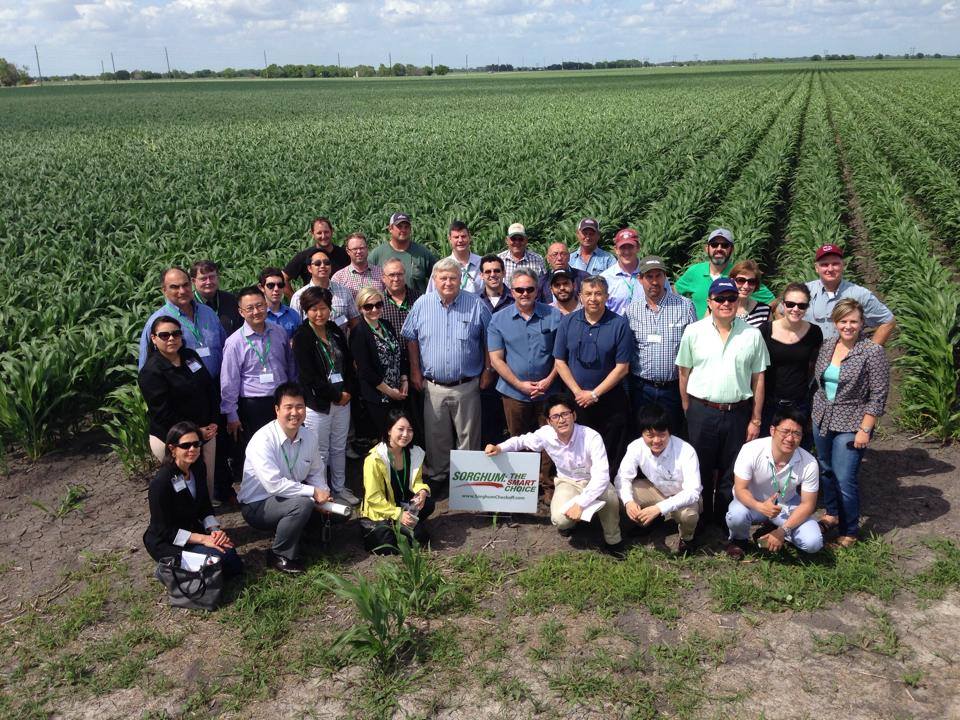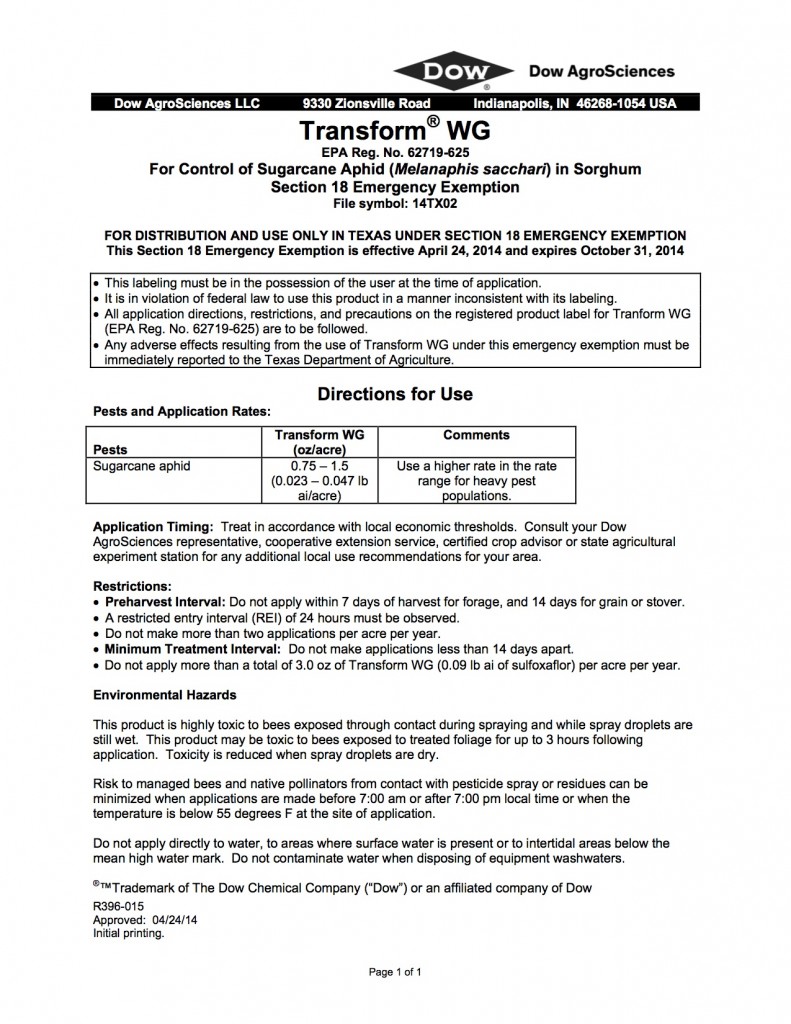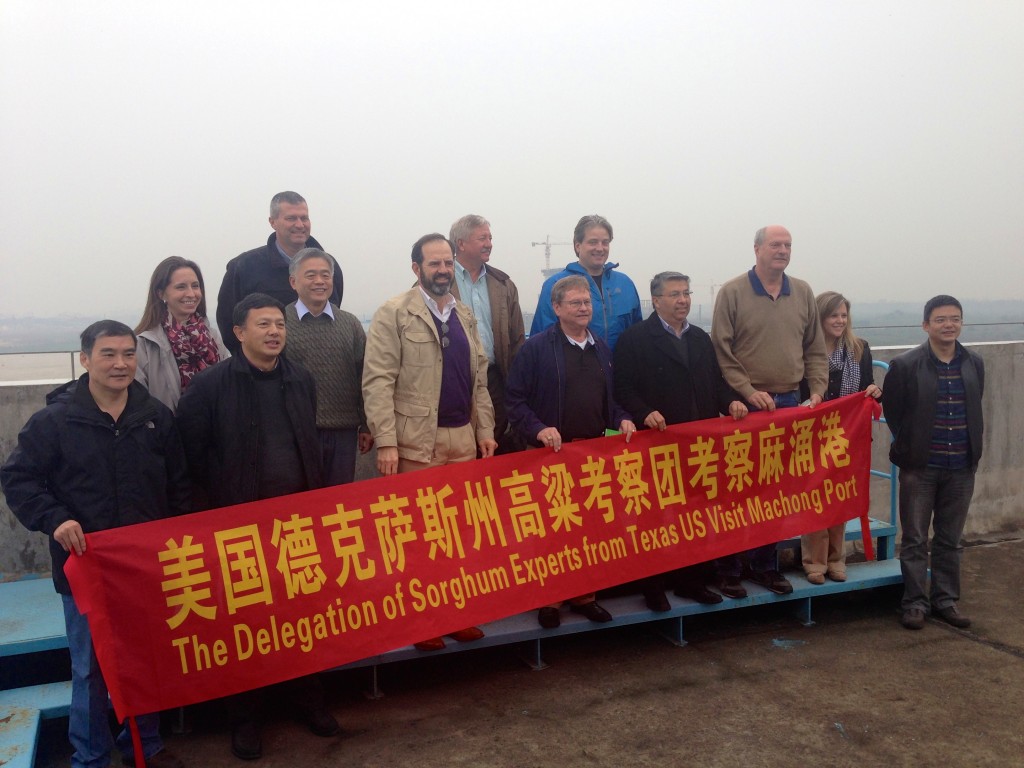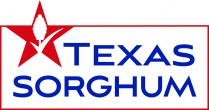- About UsTexas Grain Sorghum Association is….
- Texas Sorghum InsiderNewsletters…
- Legislative News
- Photos
- Contact UsTexas Grain Sorghum Association P.O. Box 905 Salado, TX 76571 Wayne Cleveland, Executive Director wcleveland@mindspring.com (254) 541.5375 Morgan Newsom, Producer Relations Coordinator morgan@texassorghum.org (806) 438.5994 SEND US A MESSAGE: [contact-form-7 404 "Not Found"]
- Sorghum Dashboard
- Events
July 2, 2014
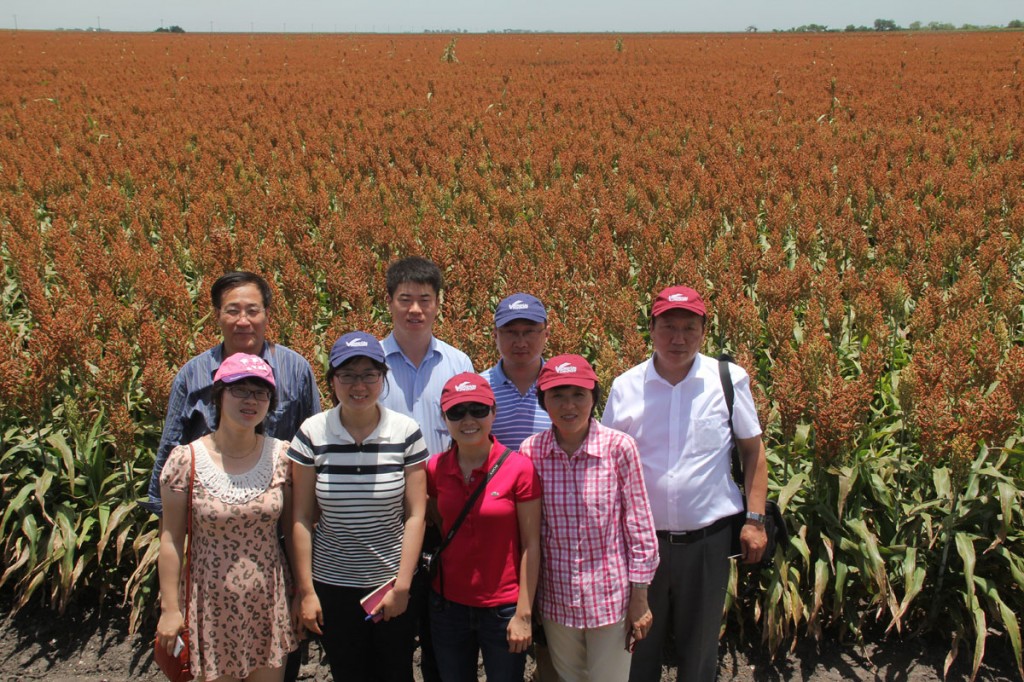
Chinese Participants on Texas Sorghum Tour. Photo taken at Clarence & Colin Chopelas field near Mathis, Texas.
International Group Participates in Crop Tour – Texas Grain Sorghum Producers (TGSP) hosted a crop tour for a group of Chinese sorghum buyers June 24-26, 2014. The Chinese sorghum buyers were primarily focused on large purchases for their duck producers. Additionally, one company was interested in containers of sorghum for vinegar production. The group was interested in current and future supplies of sorghum from Texas farmers. As part of the tour, the group visited a number of sorghum fields, which will be harvested within the next two weeks. The group also visited with several grain merchandisers during the week. The tours were across South and Central Texas, beginning near Houston, followed by the Corpus Christi area, then up to Austin, and the tour ended in the Fort Worth area. “We have really appreciated TSGP’s efforts,” Qin Zhao, with New Hope Group said. “We have gained a lot of knowledge from the farmers and grain merchandisers. This has been a very valuable trip.”
Mexico Anticipates Record Crop and Possible Exports – All indications from Mexico anticipate a sorghum crop that is 25% above normal. An estimated 310 million bushels of grain sorghum will be produced in the two major growing regions of Mexico, Sinaloa or “Bajio” and Tamulipas. With perfect growing conditions and an increasing demand for grain sorghum amongst poultry and swine producers, Mexican producers planted a record number of acres and are seeing above average yields. Mexico uses 346 million bushels of grain sorghum annually and generally imports 70 million bushels from the United States but has recently been displaced by China as the number one importer of US grain sorghum. To date, China has purchased approximately 160 million bushels of old and new crop grain sorghum. Mexico has a total feed demand of 1 billion bushels of grain, with poultry (meat and eggs) consuming 375 million bushels, and swine consuming 156 million bushels. Beef production consumes 84 million bushels and milk production requires 149 million bushels. According to ANFACA, Mexico’s feed industry association, animal production is anticipated to almost double in the coming 10 years.
USDA/NASS Release Acreage Estimates – USDA and NASS released their acreage report Monday of this week and sorghum acres are very high in Texas showing three million acres across the state. Total sorghum acres for the U.S. were down 7 percent from 2013 at around 7.5 million (estimated 6.4 million acres to be harvested from grain) compared to 8.1 million acres last year. Texas is surpassing all other states for planted sorghum acres, where the usual leader in sorghum acres – Kansas – is estimated to have planted 2.8 million acres. Texas and Kansas account for 78% of the total U.S. sorghum acreage. Corn acres in the nation are estimated at 91.6 million acres, down four percent from last year. Corn acres in Texas are estimated at 1.8 million acres. Cotton acres in Texas are estimated at 6.46 million, while the total U.S. acres are being estimated at 11.4 million.
High Yields Expected in Current Sorghum Harvest in Texas – As TGSP traveled throughout most of Texas last week on the crop tour mentioned in the first story, it was no surprise that the Southwest Farm Press is reporting that the Southern region of Texas and the Rio Grande Valley could harvest a bumper sorghum crop. As combines begin rolling, nearly a million acres of grain sorghum will be harvested in the next month. The Valley is already reporting good yields and with dryer weather in South Texas and on the Coastal Bend late last week, sorghum yields are expected to be better than average in that region also.
June 17, 2014
Changes to NSP Yield Contest – Every year growers across the sorghum belt apply to have the top producing yield in different categories in National Sorghum Producer’s Yield Contest; however, this year NSP has made some significant changes to the contest. NSP has set a new yield goal of 250 bushels per acre or more to illustrate sorghum’s yield potential, and all division placings will be determined by yield only. To reach this new benchmark, NSP is offering incentives with support from the United Sorghum Checkoff Program (USCP) to award growers who reach this bin buster. Contestants successfully participating in this category will receive a three-year truck lease (Ford, Chevrolet, Dodge, or Toyota) for first place, an all-terrain vehicle for second place, and a riding lawn mower for third place. With the new provisions, there are many new rule changes that growers should be aware of, and NSP is asking entrants to pay close attention to this years contest rules. Click here to learn more, and be sure to read their extended version of the yield contest rule changes. All winners are recognized each year at an awards banquet in conjunction with Commodity Classic, to be held next year in Phoenix, Arizona, in the Sorghum Grower magazine, and online.
BioEnergy Sorghum Could Help Greenhouse Gas Emissions – Texas A&M AgriLife recently released information from a study finding that bioenergy sorghum may offer more than another energy supply; it may offer a “sink” for greenhouse gases. Researchers at the University have been measuring greenhouse gases from biofuel production scenarios to help quantify the carbon footprint of a bioenergy cropping system and evaluate compliance with federally mandated reduction goals. The researchers conducting the study found that bioenergy sorghum may play a significant role in future biofuel production as a high quality biomass feedstock. The life cycle analyses from the crop are used to evaluate biofuel efficiency by balancing the direct and indirect greenhouse gases associated with production with the total energy output and soil carbon storage. The study has been in motion since 2008 at a field near College Station. To read AgriLife’s full story, click here.
China Sorghum Imports Expected to Continue to Rise – Bloomberg News released a report that China’s imports of coarse grain may climb to a record 3.5 million metric tons in the 12 months beginning Oct. 1, compared to a projected 3 million tons in the current period. Those numbers are taken from a median of five estimates from traders and analysts. China is the world’s largest producer, and have been cueing record amounts of sorghum after the government curbed U.S. corn imports. AccordingSorghum was traditionally used to make baijui liquor such as Moutai in China, and now the Chinese are using it to fatten ducks and hogs. Authorities in China rejected cargoes of up to 1.2 million tons of U.S. corn containing an unapproved genetically modified variety in April and since then, U.S. corn shipments to China went to the lowest level in seven months. Sorghum is a non-genetically modified crop and isn’t subject to import quota restorations in China. According to a Bloomberg survey, no sorghum was bought from China in 2012, but China may now purchase three quarters of U.S. sorghum exports this year. Next week, TGSB is hosting a crop tour across the state for international participants, and eight of them will be coming from China to learn more about this year’s sorghum crop.
CRP Sign-Ups – Beginning on June 9, 2014, landowners could begin to sign-up for the Conservation Reserve Program (CRP), one of the largest voluntary conservation programs in the country. The CRP provides incentives to producers who utilize conservation methods on environmentally-sensitive lands. CRP consists of a “continuous” and “general” sign-up period. Under continuous sign-up authority, eligible land can be enrolled in CRP at any time with contracts of up to 10 to 15 years in duration. For general sign-ups, USDA will allow producers with general CRP contracts expiring this September to have the option of a one-year contract extension. USDA will also implement the 2014 Farm Bill’s requirement that producers enrolled through general sign-up for more than five years can exercise the option to opt-out of the program if certain other conditions are met. For more information, visit www.fsa.usda.gov.
May 28, 2014
Rain Across Texas! – The image shows precipitation totals for the past 7 days across Texas. The image is provided by the National Weather Service – Advanced Hydrologic Prediction Service. To view precipitation totals for one day, one month or even the past year, visit www.weather.gov/precip/. You can also edit your search to include different states or by specific counties.
Update on Sugarcane Aphid in RGV – Danielle Sekula Ortiz of Texas A&M AgriLife Extension in the Lower Rio Grande Valley reported that sorghum fields in all 3 counties throughout the Valley are experiencing high sugarcane aphid populations. Many growers have been treating their fields and some have started to make second spray applications to control the aphid. She reminds growers to monitor their sorghum fields weekly by inspecting under flag leaves and under lower leaves. She recently held a meeting about sorghum and the sugarcane aphid. The powerpoint presentation from the meeting can be found by clicking here. To contact Danielle, you can email her at danielle.sekula@ag.tamu.edu.
Success at Export Sorghum Event – The first annual Export Sorghum Event hosted by USCP and TGSP was deemed a success by attendees. The event was held May 19-21 in Houston, Texas. There were approximately 20 international grain buyers from China, Japan, Mexico and Spain and approximately 30 domestic grain sellers. During the event, attendees were provided insight on sorghum markets, trade opportunities, nutritional values, contract education and logistics information. The significance of Export Sorghum is tremendous as it provided invaluable networking opportunities in hopes of leading to future market opportunities for sorghum producers. Attendees filled out surveys at the conclusion of the event and comments indicated it was “one of the best events I have ever attended.” Attendees related most closely with the topics covering the future of sorghum and the nutritional value of sorghum. In addition to the presentations, some of the attendees toured a sorghum operation owned by Calvin Schultz in Guy, Texas and also toured Cargill at the Port of Houston.
May 14, 2014
Sorghum Export Event – The United Sorghum Checkoff Program (USCP) and Texas Grain Sorghum Producers (TGSP) are teaming up to bring the first annual Sorghum Export Event to Texas. The event will be held next week in Houston, Texas and will bring in about 20 of the top sorghum buying companies from Mexico, China, Japan and Spain. The event will also have about 30 domestic attendees who are capable of selling grain to international customers. The topics at the event will range from transportation, sorghum supply and demand, and international contract specifications to sorghum nutritional information and sorghum specialty products. The attendees will also tour the Port of Houston and a local sorghum farm. The purpose of the event is to educate buyers on the sorghum crop, to give buyers and sellers the opportunity to network in hopes to sell more sorghum in the future, and to address any concerns or questions buyers or sellers may have about the crop.
Rio Grande Valley & the Sugarcane Aphid – Texas A&M AgriLife Extension in the Rio Grande Valley observed more pressure from the sugarcane aphid last week and many fields were sprayed for the pest. Several fields that were observed had a significantly larger number of winged females compared to the last two weeks. This leads the researchers to believe that the pests are colonizing and distributing throughout sorghum fields and populating them. However, with the recent rains, researchers feel some of the aphid induced water stress will be reduced and might impact the economic thresholds referred to above. Although this pest is showing up, there is now a insecticide growers can use to control this pest as mentioned in the next story…
Transform Labeled for Use on Sugarcane Aphid in Texas – A few weeks ago, the EPA issued a specific exemption under the provisions of Section 18 of the Federal Insecticide, Fungicide and Rodenticide Act, as amended, to the Texas Department of Agriculture for the use of sulfoxaflor (Transform), on sorghum to control sugarcane aphid in Texas. The exemption was made possible by the efforts of many agencies in Texas including your Texas Grain Sorghum Producers Association and National Sorghum Producers. Transform is manufactured by Dow Agrosciences and the label for the insecticide may be found below. This specific exemption expires on October 31, 2014 but TGSA will continue to work with the legislature to get this passed indefinitely.
Chance of El Nino – The National Weather Service and the International Research Institute for Climate and Society predicted on May 8th that the chance of the U.S. going into an El Nino increases during the remainder of the year, exceeding 65% during the summer. ENSO-neutral continued during April 2014, but with above average sea surface temperature (SST) developing over much of the eastern tropical Pacific and persisting near the International Data Line. This data shows an increased likelihood of El Nino compared with the data from April, and shows that we are most likely to transition to El Nino during the summer. There is still uncertainty as to exactly when this will develop and an even greater uncertainty as to how strong it may become. Current probabilities show El Nino to occur in June at 67%, July at 71%, August at 74%, September at 75%, and October and November at 78%.
High Plains Drought Coupled with Temperature – After reading the El Nino story above, this next story might seem contradicting; however, many different researchers look at many different aspects to determine their forecast for the future so we like to provide you with a well-rounded outlook to make your own predictions. Recent rains across the Coastal Bend, Central Texas and the Rio Grande Valley came at just the right time to save this year’s sorghum crops, but crops that are beginning to be planted in the Texas High Plains are still in dire need of moisture. A recent article by West Texas A&M University with information provided by an agricultural researcher, Dr. B.A. “Bob” Stewart, says that increasing temperatures may be more pronounced than the decreasing precipitation. Dr. Stewart analyzed precipitation and temperature data from 1895-2013 for the Texas High Plains and in his graph below shows the trend lines indicate that the precipitation pattern is directly opposite to the temperature pattern. The article goes on to state that in the past, it is expected that temperatures would be lower during wet years and higher during dry years, but the significant increase in temperature strongly suggests that the temperature is the main driver. Since 1980, the average temperature have mostly increased and are higher today than during either of the historic Dust Bowls, suggesting the downward trend of precipitation in the High Plains is likely due to increasing temperature. Dr. Stewart ends his comments by stating, “Unitil and unless there is a downward turn in the temperatures, the return to precipitation amounts received during the ‘good old days’ may not occur.” To read the full article, click here. If this trend continues, growers will have to shift their practices to accommodate the continued drought.
March 19, 2014
Overwhelming Interest from China with US Sorghum: Texas Grain Sorghum Producers (TGSB) host educational seminars in China. – TGSB, in conjunction with the United Sorghum Checkoff Program (USCP), Texas Department of Agriculture (TDA), and the U.S. Grains Council (USGC), recently conducted a series of three educational seminars across China. Each of the seminars, held in three different cities in China, provided various presentations that included growing sorghum, sourcing sorghum, transportation, and logistics of handling and shipping the grain. The seminars met an overwhelming support from Chinese customers.
“While we anticipated a good crowd, we were excited to see standing room only in each of the seminars,” said Wayne Cleveland, Executive Director of TGSB. “We estimate that approximately 600 people attended the seminars. Not only did they attend, but stayed after and asked pertinent questions and were extremely interested in meeting the folks that presented.”
Each of the seminars included various aspects of the sorghum industry. James Born, a producer from Ochiltree County and a TGSB board member, presented information regarding producing grain sorghum with no-till practices and very limited availability of water. “The Chinese were attentive to the fact that sorghum acres could grow significantly in the near future with limited water as well as advancements in yield and nutritional aspects of sorghum,” stated Born, “this indicated they are interested in a long-term purchasing relationship and wanted to ensure that stocks would be sufficient to meet their growing demand.”
Presentations also addressed the nutritional aspects of grain sorghum presented by Dr. Kimberly McCuistion of Texas A&M University Kingsville. Sourcing and transportation of grain sorghum were presented by Benjamin Smith of Attebury Grain.
Other participants on the trip included Guy Brady with Vista Exports in Houston, Ronnie Wittig with Coastal Grain Warehouse in Wharton, George Ferguson with Bailey Grain in DFW, Shelee Padget with USCP, and Carlos Guerrero with TDA.
In addition to the seminars, participants were invited to tour two major ports along the pacific coast, visit with end users, and meet with the United States Ag Trade Officials. Each participant was a recipient of the the TDA STEP grant which encourages the sale of Texas products into foreign markets.
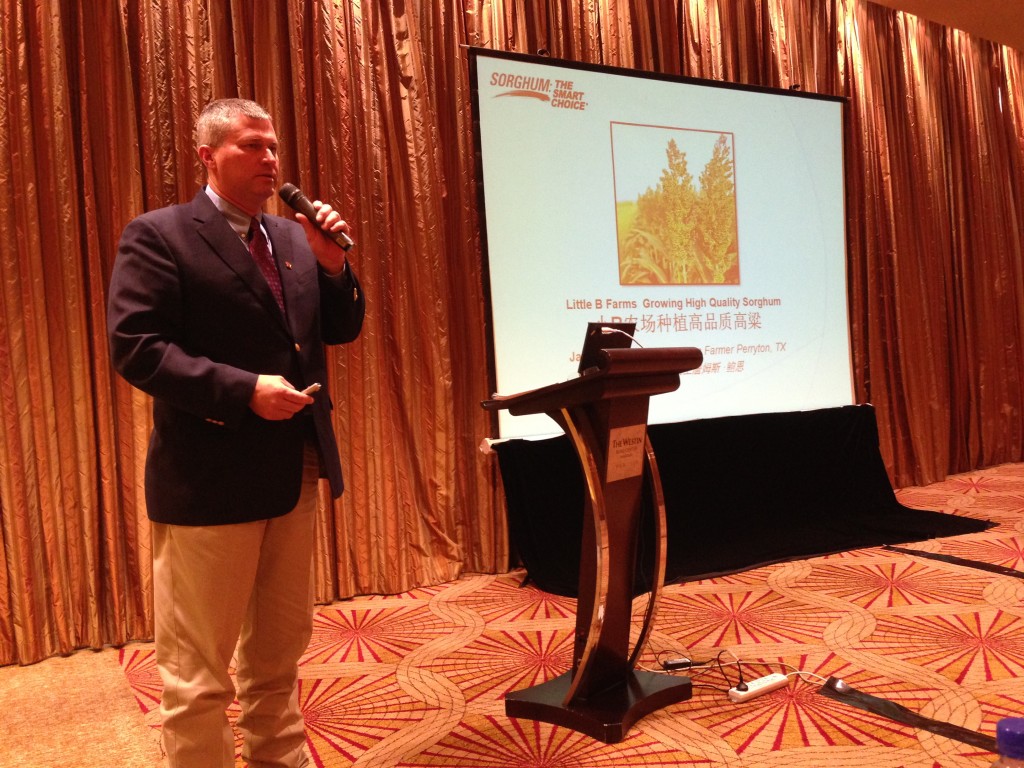
James Born, a producer form Ochiltree County and a TGSB board member, presents to potential Chinese sorghum buyers during the Texas sorghum trade mission in China.
USDA Seeks Nominations for USCP Board – USDA is seeking nominations of sorghum producers to serve on the United Sorghum Checkoff Program (USCP) Board of Directors. There are five producer member vacancies for the upcoming board. Kansas, Texas and Nebraska each have one vacant position. In addition, the board will have two At-Large vacant positions. Any sorghum producer within the U.S. that owns or shares in the ownership and risk of loss of sorghum can be considered for nomination. All eligible producers are invited to seek nominations by May 16, 2014. A sorghum producer must be nominated by a Certified Producer Organization (CPO) and submit a completed application. For more information and the contact information of the CPO in your state, and for a copy of the nomination form, visit www.ams.usda.gov/lsmarketingprograms. The USCP board is composed of 13 members who administers a research and promotion program authorized by the Commodity Promotion, Research, and Information Act of 1996. The Secretary of Agriculture selects appointees from producers nominated by CPO’s.
Farm Bill Informational Meetings – The Southwest Council of Agribusiness (SWCA), Texas A&M Food & Policy Center, and Texas A&M AgriLife Extension held and are still having Farm Bill informational meetings across the state. The Honorable Larry Combest, past-Chairman of the House Ag Committee, has been welcoming growers to the meetings and explaining the importance the Farm Bill has played and will continue to play in growers daily decisions. As speakers got into the complexity of the Farm Bill, it is important for producers to realize how each crop grown is affected by the different programs. Dr. Joe Outlaw, an economist and Director of the Texas A&M Ag & Food Policy Center, explained different options and the potential impacts that each program could play out for producers. Producers will have to make decisions by farm number and crop basis when FSA opens sign-ups (possibly in September 2014) for the new programs. Tom Sell, of Combest, Sell & Associates, concluded the meetings with an overview of the process of the Farm Bill and the importance for growers of various crops to come together to let their voices be heard in Washington. He commended the important Congressmen and Senators and the various agricultural organizations who helped to commit to the passage of the bill. He noted that this is the first bill in this administration that passed with an overall budget decrease. If you were not able to attend the meetings, you can view Dr. Outlaw’s powerpoint by clicking here. Two more meetings will be held in Texas over the next few days. The first in Lubbock on March 20 at 9:00 a.m. at the Plains Cotton Cooperative Association (PCCA) Delegate Body Room, and the second in Amarillo on March 21 at 8:30 a.m. at the Amarillo Civic Center, Regency Room B.
February 18, 2014
2014 Farm Bill Informational Sessions – The Ag & Food Policy Center (AFPC), Texas A&M AgriLife Extension, and the Southwest Council of Agribusiness (SWCA) have teamed up to put together informational sessions about the 2014 Farm Bill to give those involved in agriculture industry insight on some of the changes they will expect. For more information and updates, visit www.southwest-council.com. Dates and locations for the upcoming meetings include:
- March 3rd – El Campo
- March 4th – Beaumont area
- March 12th – Taylor
- March 13th – Waco
- March 14th – Commerce
- March 18th – Stamford
- March 19th – Lamesa
- March 20th – Lubbock
- March 21st – Amarillo
- April 7th – Corpus Christi
- April 8th – Weslaco
Aphids & Grain Sorghum – There has been various reports about the aphid pest on grain sorghum and the Sorghum Checkoff has recently released a fact sheet to better familiarize growers about this pest. Please view the fact sheet by clicking here. Some of the key facts the sheet pinpoints are that the sugarcane aphid was detected in 38 counties and parishes in 2013 with minimal infestation in south Texas, Louisiana, Oklahoma and Mississippi, and one state in Mexico; the aphid was NOT detected in the South Plains or High Plains of Texas. It also noted that from a national perspective in 2013, the aphid did not significantly impact U.S. grain sorghum production, and it is still too early to know the potential impact of the aphid to grain sorghum in the upcoming crop season. Many regions where the aphid was located in 2013 have experienced below average and freezing temperatures helping to eliminate many damaging insects such as aphids. The fact sheet also provides products on treating aphids if they are detected on growers fields. A task force is currently working on the issue and the Sorghum Checkoff and Texas Grain Sorghum Producers have funded, and are developing research focused projects specifically for this pest. Again, please click here to view the complete fact sheet.
2013 Annual USCP Report – The Sorghum Checkoff has released its annual report for their 2013 fiscal year. Click here to view the full report. In summary, there were 8.1 million acres of grain sorghum planted in 2013 with 6.5 million acres harvested. 2.3 million acres were planted in Texas, the second highest state behind Kansas at 3.1 million acres. Fourteen states planted grain sorghum in 2013. There was a total of 389 million bushels produced across the nation. Texas Grain Sorghum Board (TGSB) received $730,516 in passback funds from USCP (25% of funding collected in Texas). The Sorghum Checkoff’s expenses totaled a little over $8 million and were allocated to state passbacks (1.6 M), research ($3.9 M), market development (1.3 M), communications ($634K), administration ($520K) and USDA oversight ($16K). Important facts include: there were 150 new genetic lines available by 2014; farmers averaged 8.5 yield (bu/ac) per one inch of water applied to sorghum; 31% of sorghum’s market share was in ethanol, 27% in livestock feeding, 2% in the food industry, and 40% in exports; 100 million bushels were estimated to be sold to China in 2013-14; 2.8 gallons of ethanol per bushel of sorghum was produced on average; $866 million was added to the industry by ethanol plants; there were 1,628 minutes of video footage recorded with 16,357 views of those videos on YouTube since 2011. Again, click here to view the full report.
TGSB Funded Projects for 2014 – This past December, the Texas Grain Sorghum Producers Board (TGSB) approved seven research projects and six marketing projects for the 2014 growing season. Approved research projects totaled $58,936 and projects included investigating the sugarcane aphid, no-till/con-till cropping sequences, dry land grain sorghum trials in the Panhandle, High Plains and South Plains regions, seeding rates in the Texas Blacklands, and investigations of grain & forage sorghum use in feedlot and dairy rations. Approved marketing projects totaled $67,190 and included projects for international marketing, extruded snacks from sorghum, effects of sorghum powder on fecal parasite egg shedding in goat kids, a Farm Bill decision aid tool, the master marketer program, and the Texas Agricultural Lifetime Leadership (TALL) program. Various lead investigators were funded from Texas A&M AgriLife Research and Extension, Texas A&M University, Milo Insulation LLC, and the U.S. Grains Council.
TGSP Board Elections – The 2013 TGSB elections were canvassed on January 31st and the new board members will be seated at the TGSP board meetings in April. Troy Skarke of Claude was elected in the North District, Charles Ray Huddleston of Celina was elected in the Central District, and Dale Murden of Monte Alto, Chuck McDonald of Monte Alto and AJ Kresta of El Campo were elected in the South District. The elected board members will serve a six-year term and will join the other ten board members from across the state. TGSB consists of a total of fifteen producer board members from three districts; five from the North District, three from the Central District and seven from the South District. The number of board members from each district is based on data from past sorghum production.
January 29, 2014
House Passes Farm Bill – The Agricultural Act of 2014, also known as the Farm Bill, was approved today by the United States House of Representatives on a vote of 251 to 166. The approval comes after a lengthy five-year process of debate. The bill was whipped, where it was a first time in a long time, if not the only time, that the GOP leadership whipped the Farm Bill. After long hours of coming to an agreement in the conference committee, the House and Senate finally agreed on all of the legal language. Now that the Farm Bill has passed the House, it will go to the Senate where it hopefully passes there, and then to the final passage at the White House where it will hopefully be signed into law. The bill saves taxpayers $24 billion and provides policy certainty for rural American. The National Sorghum Producers, who has worked diligently on this bill, is a win for the sorghum industry. They noted that it does no harm to crop insurance and, in fact, strengthens the crop insurance. It offers farmers a choice of risk management options under the Commodity Title, including price loss coverage and agriculture risk coverage. Both options contain real price protection for farmers. Pay limits, eligibility requirements, and AGI limits are workable for full-time farm families. Conservation policies, including EQIP and CSP, are consolidated and streamlined but remain strong and adequately funded. It provides authorization and mandatory funding in the Energy Title for key advanced biofuel policies. The Trade, Credit, Rural Development, Research, Forestry, Energy, and Horticulture titles are similarly retained and adequately funded, with provisions promoting lower electricity costs for rural consumers – bipartisan reforms to Food Stamps are included that establish work requirements for able-bodied adults without kids, and the “heat and eat” and other loopholes in Food Stamps are closed. We thank NSP and all of the many agricultural organizations who put in the effort to make this happen. NSP and TGSA submitted letters of support to House Representatives yesterday. Stay tuned for the vote in the Senate.
TGSA Board Elections – The 2013 TGSA elections came to a close in December and new board members were seated by proxy at the board meeting last month. Danny Krienke a producer from Perryton resumes the producer seat in the North District, Warren Mayberry of DuPont/Pioneer in Austin resumes the at-large seat in the Central District, and Brian McCuistion of Planters Grain Coop in Odem resumes the at-large seat in the South District. Since there were no contested seats on any of the races, the President of TGSA made the motion to elect the board members by proxy while the full board had a majority vote to elect the board members in. The elected board members will serve a three-year term and will join the other six board members from across the state. TGSA consists of a total of nine board members from three districts; two producers and an at-large sat are represented from each district.
USCP Board Members & Sorghum Investments – In November Secretary Vilsack announced the appointment of four members to serve on the USCP Board of Directors. Producers appointed to the board, and that were sworn in at the December USCP board meeting are: Danny Krienke of Perryton, Texas, Martin Kerschen of Garden Plain, Kan., Clayton Short of Assaria, Kan., and one at-large member, Kathy Brorman of Hereford, Texas. Appointed members will serve a three-year term. Dale Artho of Wildorado, Texas and Troy Skarke of Claude, Texas had their final board meeting as board members after fulfilling two terms. A special thanks goes out to these guys for their tireless efforts and commitment to the sorghum industry. Both of these gentlemen remain active on the Texas Association and Board. Also at the December board meeting, USCP board of directors, invested $1.85 million to fund proposals targeted at furthering sorghum growers’ productivity and profitability. The Sorghum Checkoff board, external committee members and staff dedicated several months to reviewing projects in the crop improvement, high value, and renewable priority areas. USCP received 86 requested totaling $16.8 million dollars. The approved projects focused on new genetic introduction, food development, livestock nutrition, companion animal industry development, biofuels enhancement, and coproduct enhancement. Some of the organizations who are lead investigators in the projects included: Kansas State University, University of Nebraska, USDA ARS, Agri-Tech Producers, and Texas A&M AgriLife. The board will meet again in March.
Milo Insulation, LLC – This month, Milo Insulation, LLC held its grand opening in Tulia, Texas. The corporation is made up of 18 farmers and processors in Perryton, Dalhart, Pampa, Panhandle, Claude, Plainview, Wildorado, Tulia, McGregor, Temple, and Holland. The corporation was formed to primarily make natural plastic resin that can be extruded into insulation products out of sorghum. In addition to the insulation. The concept of Milo Insulation is to contract specific sorghum grain varieties with their growers before planting. They will then collect the contracted milo at the Tulia plant and it will go through a process to make it into a raw material. That raw material will then be shipped to a plant where it is extruded into insulation. The extruder pushes and stretches the raw milo and then finally puffs it up to create the insulation. A company in Dallas manufactures a special type of baked extruders that can produced the desired product lines. The milo insulation product will be affordable and superior to all alternative types of insulation except urethane foam which is excellent protection but very costly. Once the process is fully completed, the Tulia plant will supply the needs of the world in natural, green insulation products. Another product the plant produces after separating the raw material for the extrusion process, is a very powerful antioxidant powder. These materials have special uses in animal nutrition and after more research is done, hopefully for cancer fighting foods and medicines.
Water Conservation Symposium – The 2nd biennial Texas Panhandle-High Plains Water Conservation Symposium will be held Feb. 12 from 8:30 am to 4:30 pm in the Amarillo Civic Center North Exhibit Hall. The public is encouraged to attend and hear local, state, and national speakers discuss economic impacts of water conservation. The morning session includes topics such as funding opportunities following passage of Proposition 6, interim legislative charges for the next session, brackish groundwater use, aquifer storage/recovery, statewide perspectives of agricultural water conservation, and discussion of potential weather conditions in 2014. The afternoon breakout sessions will feature water conservation information in the agricultural, industrial and municipal sectors. The cost is $35 per person and includes lunch. Online registration and a full agenda is available at www.texaswater.org.
Commodity Classic in Texas – The annual Commodity Classic, featuring collaborative efforts from National Sorghum Producers, National Corn Growers Association, American Soybean Association, and National Association of Wheat Growers will be held in San Antonio, Texas on February 27, 2014 – March 1, 2014. The classic features several learning sessions of issues impacting agriculture, WIN (What Is New) sessions that showcase new products and ideas in agriculture, an engaging general session and one of the largest trade shows in the U.S. Over 6,000 people will attend classic every year. Sorghum will have its own session and the NSP will be having a PAC casino night to raise funds for legislative efforts. For more information, visit www.commodityclassic.com.
November 6, 2013
Proposition 6 Passes – A little over 1 million of the eligible 13.4 million voters in Texas turned out to the polls yesterday to mark their ballots. There were nine constitutional amendments to vote “for” or “against” on, and while all nine passed, Proposition 6 garnered the most attention and campaign funds leading up to the election. Proposition 6 is a plan to take $2 billion from the Rainy Day Fund to start a low-interest loan program for water projects in Texas. The one-time payment will go into SWIFT (State Water Implementation Fund for Texas) and will be overseen by the Texas Water Development Board (TWDB). TWDB will evaluate and prioritize projects as aligned in the state’s official Water Plan, where those projects aim to meet the state’s water needs over the next fifty years by conserving or reusing water. The legislature made serving the interests of rural communities and Texas farmers a priority by directing the TWDB to undertake applying not less than 10 percent of the funds to projects serving rural communities and Texas farmers. The SWIFT does not affect how groundwater conservation districts manage local groundwater supplies and there is no provision within Proposition 6 or its enabling legislation that would require landowners to meter their wells. Proposition 6 passed by 73.37% with 836,424 voting “for” the amendment and 303,547 voting “against” it, or 26.62%.
Grain Berry – A Sorghum Food Product – Grain Berry is a new brand that currently uses sorghum grown in the High Plains of Texas to make nutritious products that can now be found at many grocery stores. You can watch a short commercial about Grain Berry by clicking here. The short clip features past TGSA board member and sorghum grower from Plainview, Texas, Glenn Schur. Grain Berry focuses their products on the nutritional value in sorghum. The company removes the outer layer of the grain berries (sorghum) to get the high antioxidant bran and they add that bran to their whole grain oats and whole grain wheat in their various food products. Their products contain antioxidant vitamins (C and E) plus others, while also providing whole grains and natural berries of grain. Grain Berry has more antioxidants than many fruits and vegetables, including blueberries. . As noted on their website, the development of various chronic and degenerative diseases such as cancer, heart disease, Alzheimer’s and Parkinson’s disease may be attributed to oxidative stress which comes from a lack of antioxidants in your diet. Grain Berry currently produces cereals (including flavors like apple cinnamon and honey nut), pancake mixes, muffin mixes and crackers. To learn more about this product or to buy it online, visit www.grainberry.com.
TGSB 2013 Elections – Texas Grain Sorghum Producers Board (TGSB) will hold its biennial election on December 13, 2013. The current terms of five of the fifteen board members will expire at the end of this year. The North District will elect one director, the Central District will elect one director, and the South District will elect three directors. Elected directors serve a six-year term. Nomination forms have been sent out and must be postmarked to TGSB by November 13, 2013. In order to be nominated, you must get ten signatures from other sorghum growers in your voting district. Any person living within the district counties who is engaged in the business of producing, or causing to be produced, sorghum for commercial purposes, is eligible to be nominated or vote, including owners of farms and their tenants and sharecroppers, if such person is subject to paying the assessment that is collected on sorghum in Texas. Nomination forms require you to get ten signatures from other sorghum growers in your voting district. If you did not receive a nomination form and would like to obtain one, you may find them at your local elevator, local county extension office or by contacting TGSB staff at morgan@texassorghum.org. Once nominations are received, the elections will be held by mail ballot. Mail ballots must be postmarked by December 13, 2013 to TGSB.
TGSA 2013 Elections – Texas Grain Sorghum Association (TGSA) is now in the process of board member elections. The current terms of three of their nine member board will expire at the end of this year. The North District will elect one producer-member seat, the Central District will elect one at-large member seat, and the South District will elect one at-large member seat. Producer-member seats are filled and voted on by sorghum producers who are TGSA dues-paying members (either through individual membership or if they take their grain to a TGSA e-member elevator) in their voting TGSA district. Producers who wish to be nominated must get five signatures from bonified producers from their district. At-large member seats are filled and voted on by TGSA e-members and TGSA corporate members. Any e-member or corporate member may nominate someone to represent the growers in their district (producer, elevator manager, industry member, etc.). After nominations are received, e-members get one vote for every $1-$1,000 TGSA receives back from the NSP e-membership program (20%) and will receive one vote for every subsequent $1,000 received to a maximum of four votes within their voting districts. Corporate members get one vote for every $1,000 contributed, and receive one vote for every subsequent $1,000 received to a maximum of four votes within their voting districts. Nomination forms must be postmarked to TGSA by November 13, 2013. To obtain a nomination form, or for further information, please contact morgan@texassorghum.org.
October 23, 2013
First Large Shipment of U.S. Sorghum Arrives in China – On October 18, 2013 the first-ever bulk shipment of U.S. sorghum to China began unloading at the Guangzhou Port Facility. The shipment of 60,000 metric tons (2.36 million bushels) will be used for animal feed in the country and demonstrates the continuing modernization of China’s feed industry. Bryan Lohmar, U.S. Grains Council (USGC) director in China said, “The Council believes U.S. sorghum has significant potential to become a regular feed ingredient in China. Sorghum imports from the U.S. can help keep food prices low and improve China’s overall food security.” Alvaro Cordero, USGC manager of global trade, also noted “that as of this month there are approximately 20 Panamax vessels sold of U.S. sorghum to China, which represents 1.1 to 1.2 million tons (43.3 to 47.2 million bushels), and traders estimate the 2013/14 crop year should register sales of 1.6 million tons (63 million bushels) or more.” The sale comes as restrictions on corn imports through China’s tariff rate quota are providing a opportunity for the Council to to help China’s feed industry and livestock producers look at other feed ingredients. In September, USGC and the United Sorghum Checkoff Program (USCP), provided technical seminars and assistance to help the industry understand the nutritional value of sorghum, how to incorporate it into feed formulations and the potential for future sorghum export supplies from the U.S.
Conserving the Ogallala Aquifer – As we all know, agriculture depends heavily on water; and a big piece of the nations agricultural growing region relies greatly on the Ogallala Aquifer. The aquifer was already in decline, and the continued drought isn’t helping to replenish the aquifer so with those things in mind, the NRCS begins its third season of conservation work in the Ogallala Aquifer region. Many farmers in the High Plains region of Texas, who recognize the aquifers importance, are highlighted in “This American Land,” a national public television series that was recently aired on PBS in large markets nationwide. In the first episode of the series titled “Critical Aquifer,” the video shows how farmers in the region use conservation to minimize water use and prevent it from drying up in the future. To view this episode, click here. The aquifer covers about 170,000 square miles stretching from South Dakota to the Texas panhandle. The aquifer is under eight states and is used for one million acres of irrigated cropland. According to the Texas Water Development Board, Northern Texas is the most stressed section of the aquifer, where it is cut off by previously drained areas to the east and the Pagos River to the west, preventing the recharge of water from the Rocky Mountains. The NRCS is helping many farmers with conservation practices and financial assistance to help conserve the Ogallala Aquifer now and into the future. To read more about the work NRCS is doing on this project, click here.
TAWC Summer Field Day Videos – While on the subject of water conservation, the Texas Alliance for Water Conservation (TAWC) has provided videos of their summer field days on YouTube. The videos showcase several speakers demonstrating results and showcasing a variety of water conservation practices the project implements. To view these videos, click here.
2013 DCP/ACRE Direct Payments & 2012 ACRE ACRE Payments – The USDA Farm Service Agency (FSA) has recently released information about DCP and ACRE payments. The 2013 DCP/ACRE direct and 2012 ACRE ACRE payments will be processed on or about October 24, 2013 and will be available for certifying and signing throughout the day on October 24, 2013. The last day the Prepayment Report was processed was September 30, 2013. Direct payments issued under the 2013 DCP and ACRE program have been reduced by 8.6 percent due to the sequester-related reductions. The amount is applied at the payment entity level and is not attributed to members. Software allowing the entry of the COC approval date for 2009-2013 DCP/ACRE contracts was disabled as of October 1, 2013. Normal processing will resume for approving 2009-2013 DCP/ACRE contracts after modified payment software is released. For more information, visit your local FSA office.
Buyers from Mexico in Texas – This week, five buyers from Mexico are in Texas to learn about the quality of our sorghum and to network with potential sellers. The group began in the High Plains of Texas. While in the Lubbock region, the group: visited USDA to view and learn about their sorghum research; toured the local ethanol plant – Diamond Ethanol in Levelland, TX; visited Glenn Schur’s farm, a sorghum grower in Plainview; toured Cone Elevator in Lubbock; and finally visited with regional elevator managers from Attebury Grain and Gavilon Grain. Today the group headed to Houston to visit with Louis Dreyfus Commodities and tomorrow the group will tour Cargill and the Port of Victoria. Finally, the group will end the trip at the Victoria Farm and Ranch Show. The group is hosted by the U.S. Grains Council, the Sorghum Checkoff and the Texas Grain Sorghum Board. These trade missions are set-up to educate international customers about the value of Texas sorghum and with the hopes of selling more sorghum in the future.
September 24, 2013
Texas Water Development Board – Interested in viewing reports on state groundwater, surface water and the state of the drought? The Texas Water Development Board (TWDB) releases annual financial reports, state drought conditions and summaries, the State Water Plan, Texas water conditions reports, and many others on their website and it may be accessed by clicking here. TWDB is a state agency that plans for the state’s water resources and provides affordable water and wastewater services. The TWDB also provides water planning, data collection and dissemination, financial assistance and technical assistance services to the citizens of Texas.
TGSB RFP – The Texas Grain Sorghum Board (TGSB) has opened its Request for Proposals (RFP) for 2014. Proposals are due to Morgan – morgan.newsom@gmail.com by October 15, 2013. The recommended size of the proposals should be $10,000. Priorities include: applied research that improves the profitability of sorghum; marketing that addresses development of new markets; studies that involve movement of grain into markets; research that develops new uses of grain sorghum; and promotion that introduces sorghum to new sources. Proposals will be ranked and approved at the December 2013 board meeting. For more information, please contact TGSP staff.
South Texas Commodity Symposium – Join us for the 4th Annual South Texas Commodity Symposium (STCS) in conjunction with the Texas AgXchange Farm & Ranch Show in Robstown, TX! The symposium will be held on Wednesday, October 2, 2013, beginning at 9:00 a.m. with coffee and donuts. The speaking portion of the program will begin at 9:30 a.m. and end at 11:30 a.m. George Knapek, the program director for the representative farms of the Texas A&M Ag and Food Policy Center, will begin the program with a Farm Bill update. There will then be legislative and crop updates from each commodity – corn, sorghum and cotton. Those speakers include: Scott Averhoff, Texas Corn Producers Board Chairman; Tim Lust, National Sorghum Producers Executive Director; and Gary Adams, National Cotton Council Vice President of Economics and Policy Analysis. The program will conclude with a question and answer panel by all speakers. All attendees to the symposium will receive a free lunch ticket to the BBQ cook-off being held at the farm show. The symposium will be held in the Conference Center at the RMB Regional Fairgrounds. The farm and ranch show will be held from 9:00 a.m. to 4:00 p.m. on October 2nd and 3rd. For more information on events happening at the farm show, click here.
USCP Seeking External Committee Member Applicants – The Sorghum Checkoff is now accepting applications from individuals interested in serving as an external committee member on one of the board of director’s three committees: Crop Improvement, High Value Markets and Renewables. Responsibilities of external committee members include – following all USCP board policies while acting as a resource and providing supportive information, attending scheduled committee meetings and/or calls, and voting on projects and issues brought before the committee. Applicaitons can be found at www.SorghumCheckoff.com and submitted to positions@sorghumcheckoff.com. The deadline for application submission is Oct. 7, 2013. Applications will be reviewed and accepted by the board on or before Dec. 11, 2013.
